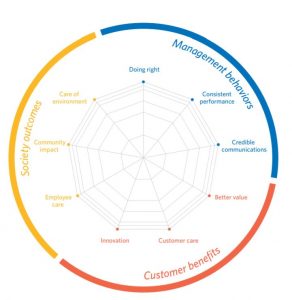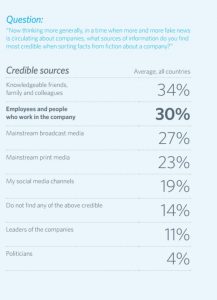There’s a new report on authenticity that caught my attention as much for what it does talk about as what’s missing. What it does well is talk about how organizations should tell their stories. What it fails to do, however, is make the connection to sustainability.
Authenticity in an Uncertain World is about value, credibility, and what customers want and expect from companies. It’s noteworthy how these issues are framed.

The report posits nine drivers of authenticity. Three are identified as management behaviors (more committed to doing the right thing, having more consistent and stable financial and operational performance, and communicating more frequently and credibly). Three are identified as customer benefits (offering products and services that are better value, taking better care of customers, and innovating new and better products and services). The final three are societal outcomes (taking better care of employees, contributing to society in a way that has a better impact on my community, and taking better care of the environment).
Or, as the report states,
“Just half our perceptions and beliefs about a company are shaped by our expectations of its products and services. The other half is influenced by information on the company itself, its culture, how it treats its staff, its attitude to social responsiblity, and more.”
Who’s credible?
It should come as no surprise that companies no longer control the conversation. That doesn’t mean that you shouldn’t have great messaging to back up your killer product or service. It just means that what you say isn’t enough.

So who’s credible? Here the report largely echoes other findings. As consumers, we trust our friends — and we trust employees. It’s not enough to put your CEO or board chairman in front of a microphone. I don’t love Zappos because their CEO wrote a book about company culture (though it is worth reading). I love Zappos because it has an awesome shoe selection, a terrific return policy, and a refreshing practice of letting its customer service agents be themselves. And when a customer service rep, unprompted, told me how proud she is that Tony Hsieh had offered to pay funeral expenses for all the Las Vegas shooting victims? That just made me happy to support a business that was engaged in its community. See how these drivers of authenticity come together?
This is also about sustainability.
The report is worthwhile as far as it goes. And it even skirts the topic of sustainability in its discussion of corporate citizenship. It notes that consumers “expect companies to play a more active part in helping to shape the society in which we live.” The report also mentions treating employees well, including equality and inclusiveness. But it never quite connects the dots.
While lots of people still equate sustainability with the environment, there are three pillars of sustainability:
- environmental
- economic
- social
Sound familiar? It’s not enough to reduce your environmental footprint. You also need to make a profit (or else your business surely will not be long-term sustainable). In addition, the societal elements encompass not just how you treat your workers but also the good or harm your activities do in the communities in which you operate.
When it comes to your business, do look at the nine drivers of authenticity. Do think about how you can tell stories that capture the way your organization is addressing these core values, whether it’s about your employees, your customer service, or how you’re doing good in your community. As you do so, however, don’t be afraid to frame this in terms of sustainability. Because sustainability is a big deal, and if you’re doing it right it’s okay to talk about it too.



